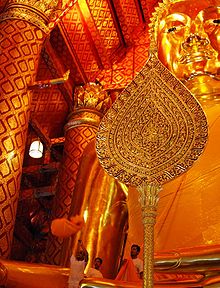Historical overview[edit]
Origins[edit]
According to the most widely accepted version of its origin, the Thai state based at Ayutthaya in the valley of the Chao Phraya River rose from the earlier, nearby Lavo Kingdom (at that time, still under the control of theKhmer Empire) and Suvarnabhumi. One source says that in the mid-fourteenth century, due to the threat of an epidemic, King Uthong moved his court south into the rich floodplain of the Chao Phraya River onto an island surrounded by rivers.[2] The name of the city indicates the influence of Hinduism in the region as it is the Thai pronunciation of the famous Indian city of Ayodhya. It is believed that this city is associated with the Thai national epic, the Ramakien, which is the Thai version of the Ramayana.
Conquests and expansion[edit]
Ayutthaya began its hegemony by conquering northern kingdoms and city-states like Sukhothai,[4]:222 Kamphaeng Phet and Phitsanulok. Before the end of the fifteenth century, Ayutthaya launched attacks on Angkor, the classical great power of the region. Angkor's influence eventually faded from the Chao Phraya River Plain while Ayutthaya became a new great power.
The emerging Kingdom of Ayutthaya was also growing powerful. Relations between the Ayutthaya and Lan Na had worsened since the Ayutthayan support of Thau Choi's rebellion In 1451, Yuttitthira, a noble of the Kingdom of Sukhothai who had conflicts with Borommatrailokkanat of Ayutthaya, gave himself to Tilokaraj. Yuttitthira urged Borommatrailokkanat to invade Phitsanulok, igniting the Ayutthaya-Lan Na War over the Upper Chao Phraya valley (the Kingdom of Sukhothai). In 1460, the governor of Chaliang surrendered to Tilokaraj. Borommatrailokkanat then used a new strategy and concentrated on the wars with Lanna by moving the capital to Phitsanulok. Lan Na suffered setbacks and Tilokaraj eventually sued for peace in 1475.
However, the kingdom of Ayutthaya was not a unified state but rather a patchwork of self-governing principalities and tributary provinces owing allegiance to the king of Ayutthaya under The Circle of Power, or themandala system, as some scholars suggested .[5] These principalities might be ruled by members of the royal family of Ayutthaya, or by local rulers who had their own independent armies, having a duty to assist the capital when war or invasion occurred. However, it was evident that from time to time local revolts, led by local princes or kings, took place. Ayutthaya had to suppress them.
Due to the lack of succession law and a strong concept of meritocracy, whenever the succession was in dispute, princely governors or powerful dignitaries claiming their merit gathered their forces and moved on the capital to press their claims, culminating in several bloody coups.[6]
Beginning in the fifteenth century, Ayutthaya showed an interest in the Malay Peninsula, but the great trading ports of the Malacca Sultanate contested its claims to sovereignty. Ayutthaya launched several abortive conquests against Malacca which was diplomatically and economically fortified by the military support of Ming China. In the early fifteenth century the Ming admiral Zheng He had established a base of operation in the port city, making it a strategic position the Chinese could not afford to lose to the Siamese. Under this protection, Malacca flourished, becoming one of Ayutthaya's great foes until the capture of Malacca by the Portuguese.[7]
First Burmese wars[edit]
Main article: Burmese–Siamese wars
Starting in the middle of the 16th century, the kingdom came under repeated attacks by the Taungoo Dynasty of Burma. The Burmese–Siamese War (1547–49) began with Burmese an invasion and a failed siege of Ayutthaya. A second siege (1563–64) led by King Bayinnaung forced King Maha Chakkraphat to surrender in 1564. The royal family was taken to Bago, Burma, with the king's second son Mahinthrathirat installed as the vassal king.[8][9] In 1568, Mahinthrathirat revolted when his father managed to return from Bago as a Buddhist monk. The ensuing third siege captured Ayutthaya in 1569 and Bayinnaung made Mahathammarachathirathis vassal king.[9]
After Bayinnaung's death in 1581, uparaja Naresuan proclaimed Ayutthaya's independence in 1584. The Thai fought off repeated Burmese invasions (1584–1593), capped by an elephant duel between King Naresuan and Burmese heir-apparent Mingyi Swa in 1593 during the fourth siege of Ayutthaya in which Naresuan famously slew Mingyi Swa (observed 18 January as Royal Thai Armed Forces day). The Burmese–Siamese War (1594–1605) was a Thai attack on Burma, resulting in the capture of the Tanintharyi Region as far as Mottama in 1595 and Lan Na in 1602. Naresuan even invaded mainland Burma as far as Taungoo in 1600, but was driven back.
After Naresuan's death in 1605, northern Tanintharyi and Lan Na returned to Burmese control in 1614.[10]
The Ayutthaya Kingdom's attempt to take over Lan Na and northern Tanintharyi in 1662–1664 failed.[11]
Foreign trade brought Ayutthaya not only luxury items but also new arms and weapons. In the mid-seventeenth century, during King Narai's reign, Ayutthaya became very prosperous.[12] In the eighteenth century, Ayutthaya gradually lost control over its provinces. Provincial governors exerted their power independently, and rebellions against the capital began.
Second Burmese wars[edit]
In the mid-eighteenth century, Ayutthaya again became ensnared in wars with the Burmese. The Burmese–Siamese War (1759–60) begun by the Konbaung Dynasty of Burma failed. TheBurmese–Siamese War (1765–67) resulted in the sack of the city of Ayutthaya and the end of the kingdom by debellatio in April 1767.




No comments:
Post a Comment